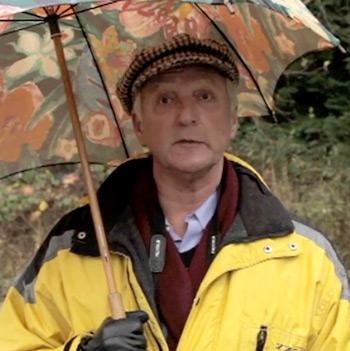VIDEO – A combination of remediation methods could be used to restore a contaminated site in the heart of Powell River. Powell River Botanic Garden Society is exploring the possibility of remediating and restoring the former waste transfer site into a botanical garden.
Members of the society see the site as an opportunity to research how plants may be used to remove contaminants, potentially at considerably less cost than other remediation methods, such as transporting the contaminated soils to a secure landfill. At the same time, the society hopes to create an attractive public space.
Dr. Val Schaefer, from the restoration of natural systems program at University of Victoria, visited the site on Monday, November 19 and gave a lecture that evening at the Powell River campus of Vancouver Island University. He explained it would be possible to combine methods of phytoremediation (plants), bioremediation (bacteria) and mycoremediation (fungi) in an ecological restoration framework, referred to as ecoremediation.
The site, approximately 10 hectares, is located close to the ocean and has a creek flowing down one side. Between 1972 and the early 1990s, the site was used for the operation of a pit-burner, which took household, commercial and paper mill waste.
The bulk of the contaminated fly ash is located in two piles on the site. There is also a large pile of tires on the site.
Ecological restoration is the process of assisting the recovery of an ecosystem that has been degraded, damaged or destroyed, Schaefer explained. “The site that we’re dealing with is really altered,” he said. “It might be very difficult to re-establish what was there before.”
With remediation, there are usually many things going on at the same time, Schaefer explained. “One step leads into another,” he said, adding that results in a combining process. Overall, the recommendation for the Powell River site is to use multiple species in the remediation process and focus on soil building and succession toward a functioning ecosystem.
In terms of addressing the incinerator ash, most contaminated ash on the site should be removed, Schaefer said, if that is an option. If it’s not an option, then the pile should be inverted and buried. Then another layer of soil should be layered on top of it. Then the phytoremediation and mycoremediation can start. “You’re trying to, in some way, cover or bury the most contaminated material on the surface,” he said
One of the concerns is dust that comes off the site, Schaefer added. “People walking across the surface, or working on the surface, inhale the dust from the site. Supposedly, what’s right on top is going to be the most contaminated, so you’re trying to, in some way, bury that and leave it less of a hazard for people that are on the site itself.”
The ash piles were tested in 1995. Schaefer provided results for heavy metal concentrations and compared them to the standards for agricultural land, which is the same for parks. The standard for copper is 63 micrograms per gram and the testing showed levels of 1,080. For lead, the standard is 70, while tests resulted in 2,410. For zinc, the standard is 200 and the tests showed 19,000.
Powell River Regional District’s solid waste management plan, which is still waiting for approval from the provincial ministry of environment, has identified the site as one of the former landfills in the city that has to be properly closed. The first step in that process is to develop a closure plan, which will include a detailed assessment to identify all sources and types of contamination.



